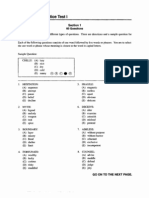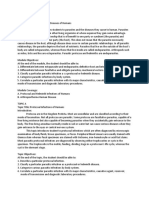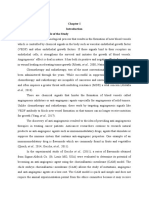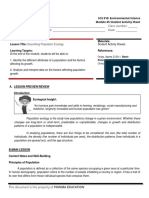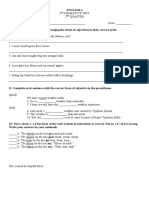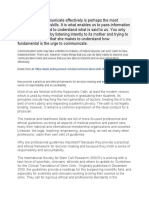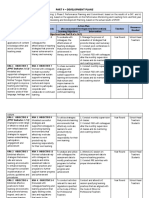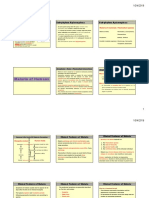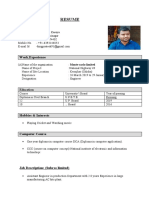100%(1)100% found this document useful (1 vote)
367 viewsGrade 7 Answer Sheet Q2M2
Grade 7 Answer Sheet Q2M2
Uploaded by
Marian Alexis FernandezThe document provides information about using a compound microscope, including:
1. It lists the magnifications of the ocular/eyepiece (10x, 10x, 10x) and objectives (4x, 10x, 40x, 100x) of a compound microscope.
2. It describes how to prepare a wet mount specimen on a glass slide using a cover slip and adjusting the eyepiece and objectives to view it clearly.
3. It explains that total magnification is calculated by multiplying the eyepiece magnification by the objective magnification, using the example of a 10x eyepiece and 40x objective providing 400x total magnification.
Copyright:
© All Rights Reserved
Available Formats
Download as DOCX, PDF, TXT or read online from Scribd
Grade 7 Answer Sheet Q2M2
Grade 7 Answer Sheet Q2M2
Uploaded by
Marian Alexis Fernandez100%(1)100% found this document useful (1 vote)
367 views1 pageThe document provides information about using a compound microscope, including:
1. It lists the magnifications of the ocular/eyepiece (10x, 10x, 10x) and objectives (4x, 10x, 40x, 100x) of a compound microscope.
2. It describes how to prepare a wet mount specimen on a glass slide using a cover slip and adjusting the eyepiece and objectives to view it clearly.
3. It explains that total magnification is calculated by multiplying the eyepiece magnification by the objective magnification, using the example of a 10x eyepiece and 40x objective providing 400x total magnification.
Copyright
© © All Rights Reserved
Available Formats
DOCX, PDF, TXT or read online from Scribd
Share this document
Did you find this document useful?
Is this content inappropriate?
The document provides information about using a compound microscope, including:
1. It lists the magnifications of the ocular/eyepiece (10x, 10x, 10x) and objectives (4x, 10x, 40x, 100x) of a compound microscope.
2. It describes how to prepare a wet mount specimen on a glass slide using a cover slip and adjusting the eyepiece and objectives to view it clearly.
3. It explains that total magnification is calculated by multiplying the eyepiece magnification by the objective magnification, using the example of a 10x eyepiece and 40x objective providing 400x total magnification.
Copyright:
© All Rights Reserved
Available Formats
Download as DOCX, PDF, TXT or read online from Scribd
Download as docx, pdf, or txt
100%(1)100% found this document useful (1 vote)
367 views1 pageGrade 7 Answer Sheet Q2M2
Grade 7 Answer Sheet Q2M2
Uploaded by
Marian Alexis FernandezThe document provides information about using a compound microscope, including:
1. It lists the magnifications of the ocular/eyepiece (10x, 10x, 10x) and objectives (4x, 10x, 40x, 100x) of a compound microscope.
2. It describes how to prepare a wet mount specimen on a glass slide using a cover slip and adjusting the eyepiece and objectives to view it clearly.
3. It explains that total magnification is calculated by multiplying the eyepiece magnification by the objective magnification, using the example of a 10x eyepiece and 40x objective providing 400x total magnification.
Copyright:
© All Rights Reserved
Available Formats
Download as DOCX, PDF, TXT or read online from Scribd
Download as docx, pdf, or txt
You are on page 1of 1
MAMBALING NATIONAL HIGH SCHOOL Ocular / Objective Total
Eyepiece Magnification Magnification
Mambaling, Cebu City Magnification
10x 4x 1.
Name: ___________________________________________ 10x 10x 2.
10x 40x 3.
Grade 7 Section: ___________________________________
10x 100x 4.
Teacher:
What I Have Learned
SCIENCE Directions. Complete the paragraph using the words inside the box. Write
your answers in the space provided.
QUARTER 2 - MODULE 2:
Microscopy: Using the Compound Microscope 40x Mirror Inverted Cover slip Field of view
Pencil Eyepiece Objectives Glass slide Magnification
PRE-ASSESSMENT ASSESSMENT
Write the LETTERS ONLY Write the LETTERS ONLY The microscope is an essential tool in Biology. It provides us with
1. 6. 11. 1. 6. 11. important data on specimens being examined. The (1) ________________
2. 7. 12. 2. 7. 12. has various magnifications (5x, 10x, 12.5x, 15x) which attaches to the body
3. 8. 13. 3. 8. 13. tube. On the other hand, the revolving nosepiece is attached by (2)
_______________ with 10x, 40x and 100x magnifications.
4. 9. 14 4. 9. 14
5. 10. 15. 5. 10. 15. In preparing a wet mount, place the specimen in a (3) ________________,
add a drop of water and cover it with a (4) ________________________.
What’s In: Let us have a simple recall of what we have learned. Tap the cover slip with the eraser-end of a (5) ______________________
Directions: Match the parts of the compound microscope in Column A to reduce the formation of the bubbles.
with its functions in Column B. Write the letter of the correct answer
before the number. Look at the eyepiece and adjust the (6) ______________________to find
the (7) ________________________ of the microscope which is the bright
Column A Column B circle of light. The (8) ____________________ of specimen is computed by
multiplying the magnification of the eyepiece with the magnification of the
__________1. Arm A. enlarge the specimen 4x objectives. If the eyepiece has a magnification of 10x and the objective has
__________2. Base B. where to grasp or hold (9) ____________________, then the specimen’s magnification is 400x. In
__________3. Stage C. enlarge the specimen 40x addition, turning the stage knob upward will result to moving the
__________4. Mirror D. holds different objectives specimen as seen in the microscope downward while turning the stage
__________5. Eyepiece E. used for more precising focus knob to the left will move the specimen to the right as seen under the
__________6. Diaphragm F. where specimen is found microscope. Finally, the specimen when seen under the microscope
__________ 7. Dust Shield G. Protect the objectives from dust appears (10) _____________________.
__________8. Stage Clip H. holds the glass slide on the stage
__________ 9. Scanner Objectives I. where you look on the specimen What I Can Do
__________10. Inclination Joint J. locates and enlarge specimen 10x
__________11. Low power Objectives K. tilts the microscope to a desired angle 1. When you get sick, what does the doctor usually do before giving a
__________12. Revolving Nosepiece L. supports the whole weight of the prescription, apart from physical check-up?
__________13. High Power Objectives microscope _____________________________________________________________
__________14. Fine Adjustment knob M. reflects light from the source to _____________________________________________________________
__________15. Coarse adjustment knob the specimen _____________________________________________________________
O. regulates the amount of light _____________________________________________________________
striking the specimen _____________________________________________________________
_____________________________________________________________
2. How useful are the microscopes in hospitals?
Activity 1 STORY LAB: MICROSCOPES AND THE LETTER “e” _____________________________________________________________
Guide Questions
_____________________________________________________________
1. Which objective lens is the shortest?
_____________________________________________________________
_____________________________________________________________
_____________________________________________________________
2. What did Jenny notice right away about the letter “e” when first viewed
_____________________________________________________________
in using scanning objective?
_____________________________________________________________
_____________________________________________________________
3. What was the line she saw in the viewing field?
_____________________________________________________________
4. What knob is used to focus the microscope when using the low power
objective?
_____________________________________________________________
_____________________________________________________________
5. What knob is used to focus the microscope when using the high power
objective?
_____________________________________________________________
____ ________________________________________________________
6. Based from the storylab, what are the steps in viewing the letter “e”
specimen using the microscope?
_____________________________________________________________
_____________________________________________________________
_____________________________________________________________
_____________________________________________________________
_____________________________________________________________
_____________________________________________________________
Activity 2 CALCULATING TOTAL MAGNIFICATION
Formula:
Total Magnification = Ocular Lens Power X Objective Lens Power
Total Magnification = Eyepiece X Objective Magnification
= 10x X 10x
= 100x
You might also like
- SSAT Lower Level Test 1Document34 pagesSSAT Lower Level Test 1Kevin Jang83% (6)
- Pssgdacquil - Virtual Crime Lab TourDocument2 pagesPssgdacquil - Virtual Crime Lab Tourᜐᜌ᜔ᜎᜓ ᜐᜌ᜔ᜎᜓNo ratings yet
- LPU-Laguna Journal of Allied Medicine Vol. 3 No. 1 August 2018Document11 pagesLPU-Laguna Journal of Allied Medicine Vol. 3 No. 1 August 2018Chester Andasan100% (1)
- Activity Human Eye and CameraDocument2 pagesActivity Human Eye and CameraCiv Nortub100% (1)
- Grade 7STE Science 2nd QuarterDocument7 pagesGrade 7STE Science 2nd Quarterjovdoctolero15No ratings yet
- WORKTEXT IN ENGLISH 5 - 4thQtr - W2 - Cause and EffectDocument11 pagesWORKTEXT IN ENGLISH 5 - 4thQtr - W2 - Cause and Effectdinnes masubayNo ratings yet
- Q1-Week 1 OBJECTIVE: To Infer Meaning of Idiomatic Expressions Using Context CluesDocument9 pagesQ1-Week 1 OBJECTIVE: To Infer Meaning of Idiomatic Expressions Using Context CluesCatherine RenanteNo ratings yet
- Assignment 3Document2 pagesAssignment 3Ian Mark Loreto RemanesNo ratings yet
- Real News PatrolDocument3 pagesReal News PatrolAnonymous WGTMTkHENsNo ratings yet
- Module 14Document9 pagesModule 14mirai desuNo ratings yet
- Solemnity of Christ The King 2019 Official Song Line UpDocument21 pagesSolemnity of Christ The King 2019 Official Song Line UpJulius Soriano100% (1)
- Esp 9 and 10Document4 pagesEsp 9 and 10James FulgencioNo ratings yet
- Test Questions For Incoming Grade 7Document12 pagesTest Questions For Incoming Grade 7Ruvhel Gamayot100% (1)
- MATH 8 QE FinalDocument6 pagesMATH 8 QE FinalJessa Banawan Edulan0% (1)
- DLP Gr9-Holticulture 1stQtr Week1-6-FinalDocument38 pagesDLP Gr9-Holticulture 1stQtr Week1-6-FinalAnn KimNo ratings yet
- Module 2: Data Collection and Sampling DesignDocument8 pagesModule 2: Data Collection and Sampling DesignKimberly BanuelosNo ratings yet
- Science-8: National Christian Life CollegeDocument6 pagesScience-8: National Christian Life CollegeLannayah coNo ratings yet
- Laboratory WorksDocument52 pagesLaboratory WorksmagocharlsdarwinbaliguatNo ratings yet
- Jhs. Science 10. First Monthly ExamDocument2 pagesJhs. Science 10. First Monthly ExamCamille Manlongat0% (1)
- Certification, Authentication & Verification (CAV) Form: For The Applicant / RepresentativeDocument1 pageCertification, Authentication & Verification (CAV) Form: For The Applicant / RepresentativeMa Michelle FranciscoNo ratings yet
- Jpia MCL Outreach Evaluation FormDocument1 pageJpia MCL Outreach Evaluation FormMedina PangilinanNo ratings yet
- Research I Q2M4 - Data Log Book & ISEF FormsDocument3 pagesResearch I Q2M4 - Data Log Book & ISEF FormsAlmie PabiaNo ratings yet
- Worksheet 1 - SolutionDocument4 pagesWorksheet 1 - SolutionKen TangNo ratings yet
- Oral-Communication11 Q1 Module6xDocument32 pagesOral-Communication11 Q1 Module6xjoewelynmasaretaNo ratings yet
- 1st Periodic Test - English 7Document6 pages1st Periodic Test - English 7Jane Colasito CerenaNo ratings yet
- USANT CHAPTER 1 and 2 ACCEPTABILITY-OF-POWER-POINT-PRESENTATIONDocument37 pagesUSANT CHAPTER 1 and 2 ACCEPTABILITY-OF-POWER-POINT-PRESENTATIONAl LexNo ratings yet
- LAS GenPhysics1 MELC 4 Week 4.ADocument10 pagesLAS GenPhysics1 MELC 4 Week 4.AMonica SolomonNo ratings yet
- St. Louis Review Center, Inc.: Multiple ChoicesDocument6 pagesSt. Louis Review Center, Inc.: Multiple ChoicesJorge Mrose26No ratings yet
- Math in Our World - Module 3.3Document13 pagesMath in Our World - Module 3.3Gee Lysa Pascua VilbarNo ratings yet
- A Narrative ReportDocument1 pageA Narrative ReportChester Allan Miguel-Eduria100% (4)
- Module 9 3is Interpretation and Presentation of ResultsDocument13 pagesModule 9 3is Interpretation and Presentation of ResultsKhian ReluniaNo ratings yet
- CAM Assay: STC 12 4M PDFDocument32 pagesCAM Assay: STC 12 4M PDFJensen AdrianoNo ratings yet
- Republic Act No. 8749Document72 pagesRepublic Act No. 8749Vanjared OcampoNo ratings yet
- Module 3 - StatisticsDocument30 pagesModule 3 - StatisticsJomil CompelNo ratings yet
- Ex. 1 Wet Mount PreparationDocument2 pagesEx. 1 Wet Mount PreparationAphril Joy LoberianoNo ratings yet
- 7 Science Q1 W6 Module 6Document11 pages7 Science Q1 W6 Module 6Shiela Mae NuquiNo ratings yet
- DepEd Qualitative ResearchDocument35 pagesDepEd Qualitative ResearchRaquel M. MendozaNo ratings yet
- Second Periodical Exam ReviewerDocument15 pagesSecond Periodical Exam ReviewerJoel FernandezNo ratings yet
- Science: Quarter 1-Module 5Document31 pagesScience: Quarter 1-Module 5Jelly ManagaytayNo ratings yet
- Science: Quarter 2 - Module 2: Focusing Under The Compound MicroscopeDocument17 pagesScience: Quarter 2 - Module 2: Focusing Under The Compound MicroscopeRica SarmientoNo ratings yet
- 2nd Quarter Exam Science 7Document2 pages2nd Quarter Exam Science 7Franklin John SargadoNo ratings yet
- 4TH Quarter Examination Grade 7Document3 pages4TH Quarter Examination Grade 7Keith Owen GarciaNo ratings yet
- ACKNOWLEDGEMENTDocument3 pagesACKNOWLEDGEMENTwendyNo ratings yet
- Sample Diary Curriculum Map Subject: Tle - Hele - Handicraft Quarter: 2 GRADE LEVEL: Grade 7 / 8 (Exploratory) Topic: Produce Recycled ProjectDocument4 pagesSample Diary Curriculum Map Subject: Tle - Hele - Handicraft Quarter: 2 GRADE LEVEL: Grade 7 / 8 (Exploratory) Topic: Produce Recycled ProjectredenNo ratings yet
- Me Sci 10 q2 0602 TGDocument34 pagesMe Sci 10 q2 0602 TGCrispin Daniel MuñozNo ratings yet
- ENVI SCI SAS Day 5Document8 pagesENVI SCI SAS Day 5Ed Jonel IngalNo ratings yet
- The Feasibility of Onion (Allium Cepa) Peels As The Main Ingredient For Bioplastic MaterialsDocument5 pagesThe Feasibility of Onion (Allium Cepa) Peels As The Main Ingredient For Bioplastic MaterialsAngel FabularNo ratings yet
- Lesson 9 - Exploring Z ScoresDocument40 pagesLesson 9 - Exploring Z ScoresJennifer MagangoNo ratings yet
- 3 A-Phenomenological-Study-On-The-Lived-Experience-Of-The-Out-of-field-MentorsDocument9 pages3 A-Phenomenological-Study-On-The-Lived-Experience-Of-The-Out-of-field-MentorsMEG MONTNo ratings yet
- 40 Item Test Science 6with Key To CorrectionDocument5 pages40 Item Test Science 6with Key To CorrectionvinnNo ratings yet
- Entrep Week 7Document13 pagesEntrep Week 7Pantz Revibes PastorNo ratings yet
- Eng ST3 Q2Document2 pagesEng ST3 Q2Nasha100% (1)
- Summative TestDocument2 pagesSummative TestMark CabaluNo ratings yet
- 30 Module 30 - q1 - General Physics 1Document14 pages30 Module 30 - q1 - General Physics 1zamora pegafiNo ratings yet
- AE - LS2-Scientific Literacy and Critical Thinking SkillsDocument3 pagesAE - LS2-Scientific Literacy and Critical Thinking SkillsCatherine Camacho TamposNo ratings yet
- Statistics Initial Presentation (Handout)Document20 pagesStatistics Initial Presentation (Handout)Jaycon MalicdemNo ratings yet
- Intermediate Biology Olympiad Question PaperDocument43 pagesIntermediate Biology Olympiad Question Paperkatie weiNo ratings yet
- Contemporary World New Generation CurrencyDocument7 pagesContemporary World New Generation CurrencySoojoo HongNo ratings yet
- Physical Characteristics of The EarthDocument5 pagesPhysical Characteristics of The EarthAndrew mulabbiNo ratings yet
- Micro para Experiment 1Document5 pagesMicro para Experiment 1CharlesNo ratings yet
- Activity - Intro To MicroscopesDocument4 pagesActivity - Intro To MicroscopesJose Angelo Soler NateNo ratings yet
- Projectile Motion1Document31 pagesProjectile Motion1Marian Alexis FernandezNo ratings yet
- Grade 7 Answer Sheet Q2M3Document2 pagesGrade 7 Answer Sheet Q2M3Marian Alexis FernandezNo ratings yet
- Grade 7 Answer Sheet Q2M4Document2 pagesGrade 7 Answer Sheet Q2M4Marian Alexis FernandezNo ratings yet
- Grade 7 Answer Sheet Q2M1Document1 pageGrade 7 Answer Sheet Q2M1Marian Alexis FernandezNo ratings yet
- Mambaling, Cebu City: Mambaling National High SchoolDocument2 pagesMambaling, Cebu City: Mambaling National High SchoolMarian Alexis FernandezNo ratings yet
- For The Clinical Translation of Stem Cells. Originally Published in DecemberDocument2 pagesFor The Clinical Translation of Stem Cells. Originally Published in DecemberMarian Alexis FernandezNo ratings yet
- Kaila Kang GemmaDocument1 pageKaila Kang GemmaMarian Alexis FernandezNo ratings yet
- Jema Ra Ni TananDocument2 pagesJema Ra Ni TananMarian Alexis FernandezNo ratings yet
- RubricsDocument2 pagesRubricsMarian Alexis Fernandez75% (4)
- ScriptDocument7 pagesScriptMarian Alexis FernandezNo ratings yet
- Identification of The Problems of Saraiki Speakers of English inDocument10 pagesIdentification of The Problems of Saraiki Speakers of English inSaif Jutt0% (1)
- GRADE 4 - DATESHEET and SYLLABUS (SA-1)Document2 pagesGRADE 4 - DATESHEET and SYLLABUS (SA-1)RahulNo ratings yet
- Wa0000Document90 pagesWa0000Mimi juwonNo ratings yet
- Acr Form Bs-16 in PDFDocument5 pagesAcr Form Bs-16 in PDFJahangir KhanNo ratings yet
- Sample of Fieldwork SchedulingDocument3 pagesSample of Fieldwork SchedulingbataraNo ratings yet
- Two KindsDocument4 pagesTwo Kindsyahia farouqNo ratings yet
- X SF STD InvDocument1 pageX SF STD Invasadahmedkhan129611No ratings yet
- Principles and Practices of Transportation Planning and Engineering 1st Edition Tang Connie download pdfDocument40 pagesPrinciples and Practices of Transportation Planning and Engineering 1st Edition Tang Connie download pdfygorniaone100% (5)
- Machine Foundation 111xlsxls PDF FreeDocument27 pagesMachine Foundation 111xlsxls PDF FreeSeo Jeong YoullNo ratings yet
- Sample Ipcrf-Development Plan 2021 - 2022 - MTDocument3 pagesSample Ipcrf-Development Plan 2021 - 2022 - MTMA. JOAN HEMBRANo ratings yet
- VSO Social Accountability Report 2014Document32 pagesVSO Social Accountability Report 2014tmrogers100% (1)
- Azure PaaSDocument3 pagesAzure PaaSNew sonNo ratings yet
- Heide EvaluationDocument3 pagesHeide Evaluationapi-531697449No ratings yet
- Sahyadri School & Aman SetuDocument28 pagesSahyadri School & Aman SetuMokshesh Jain100% (2)
- SZL 406 Subphylum Apicomplexa - October 2019Document17 pagesSZL 406 Subphylum Apicomplexa - October 2019AngieNo ratings yet
- Padolina, Diana Marie R. - Exercise 1Document2 pagesPadolina, Diana Marie R. - Exercise 1dm3store.05No ratings yet
- Ido-Guide (Ido-Guido) : For Doctors, Nurses, Stretcher-Bearers, The Wounded, The Sick, SoldiersDocument17 pagesIdo-Guide (Ido-Guido) : For Doctors, Nurses, Stretcher-Bearers, The Wounded, The Sick, SoldiersfelixespoNo ratings yet
- Actionplan On Catch Up Friday ReadingDocument4 pagesActionplan On Catch Up Friday ReadingRuth Congson EspinaNo ratings yet
- Daftar Kuantitas Harga Videotron KopassusDocument1 pageDaftar Kuantitas Harga Videotron Kopassusdimasdudut channelNo ratings yet
- Designing Services That DeliverDocument11 pagesDesigning Services That DeliverDiego MorenoNo ratings yet
- Manjusrinamasagiti in Brills EncyclopeDocument7 pagesManjusrinamasagiti in Brills EncyclopeozergyalmoNo ratings yet
- Infant Growth and DevelopmentDocument111 pagesInfant Growth and DevelopmentAdnan QamarNo ratings yet
- Literature Review of Private Equity in IndiaDocument7 pagesLiterature Review of Private Equity in Indiafvdra0st100% (1)
- Brand ManagementDocument12 pagesBrand ManagementRajat VijNo ratings yet
- UroosaDocument2 pagesUroosaMohd EisaNo ratings yet
- Sandeep RESUMEDocument2 pagesSandeep RESUMEAniket SinghNo ratings yet
- English 9 PDFDocument18 pagesEnglish 9 PDFDiane Jasmine JamandronNo ratings yet
- TDA in Retrofitting RMG Factory BLDGDocument9 pagesTDA in Retrofitting RMG Factory BLDGAbdul Malek SikderNo ratings yet
- People V PeraltaDocument1 pagePeople V PeraltaTimothy WilliamsNo ratings yet
